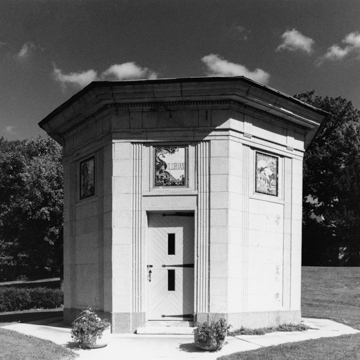This small octagonal concrete-block building with its fluted piers and abstracted frieze reflects the stylized classicism of the 1920s. Wall panels of colored tile depict romantic images of Indians. Stylized letters spelling “Silurian” refer to the ancient geological period in which Wauwatosa’s aquifer and dolomite deposits were formed.
This small pavilion recalls the city’s heyday as a thriving Victorian resort where tourists flocked to bathe and drink from mineral springs, which the era’s homeopaths claimed were medicinal. Between 1869 and 1900, investors purchased the springs and surrounded them with hotels, parks, and band shells. Waukesha catered to wealthy nineteenth-century Americans who wanted to escape the city, “take the waters,” restore their health, and socialize. Like other local spas—Bethesda, Arcadian, White Rock—the Silurian boasted beautifully landscaped gardens. Later, it offered an open-air theater and, after 1893, a casino. A gazebo-like pavilion of 1880 (demolished) sheltered the spring itself. The Silurian spa also had a bathhouse and a bottling plant. Bottled water became another major industry here, with White Rock the best-known brand.
Waukesha’s spas declined in the early 1900s as the automobile enabled tourists to take vacations and as Americans lost faith in medicinal water. The Silurian’s gardens deteriorated, and its bottling plant closed in the 1920s. Like Waukesha’s other springhouses, the pavilion sheltering the Silurian was razed, replaced by this little octagonal building in 1928.


